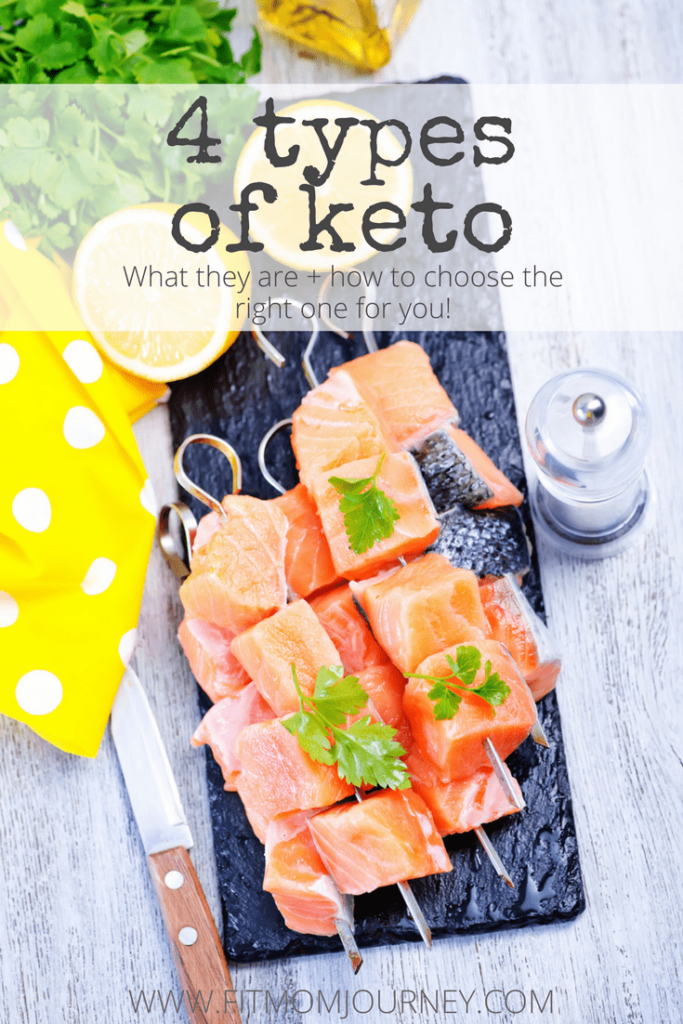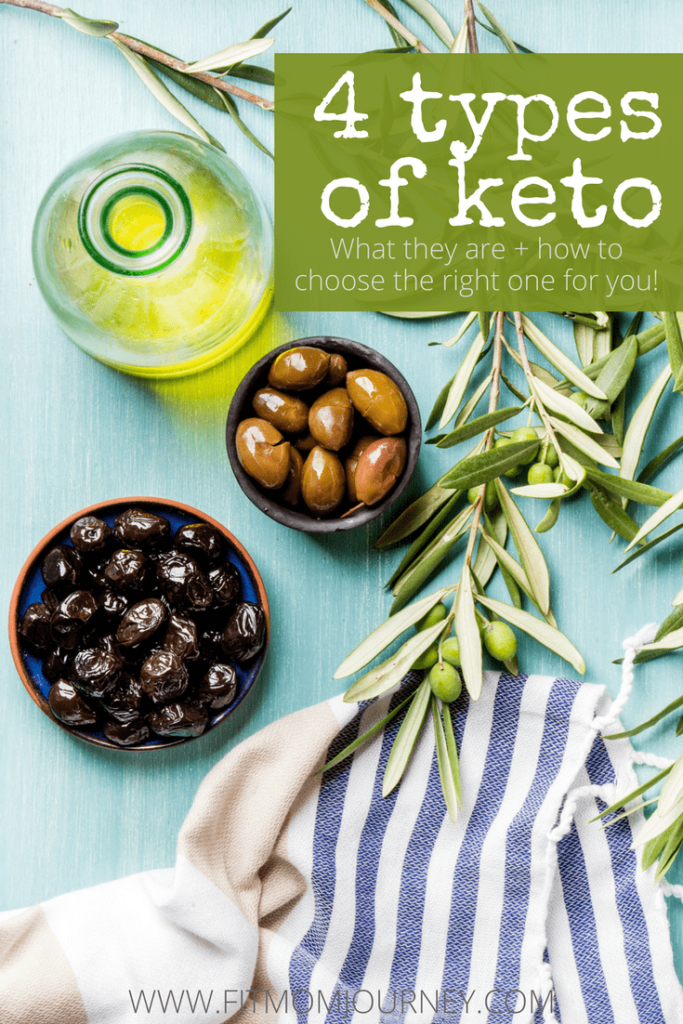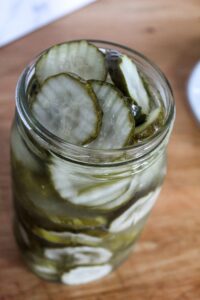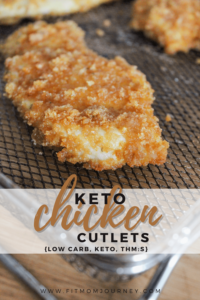
4 Types of Ketogenic Diets
The popularity of the Ketogenic Diet is at an all-time high. I know I discovered it because of it’s surging popularity on Instagram, and since then I’ve seen news segments, celebrities, and more picking up the Ketogenic Diet as a way to feel better, lose weight, enhance their mental clarity, heal diseases and more.
But did you know that there are 4 Types of Ketogenic Diets?
After all, the Ketogenic Diet has some seriously amazing benefits:
- Weight Loss/Better Body Composition
- Disease Improvement & prevention (PCOS, Diabetes, High Cholesterol, High Blood Pressure, etc)
- Mental Clarity
- Increased All-Day Energy
- Decreased Inflammation
- Improved Immunity
- Appetite Reduction
6 Reasons YOU Should Go Keto {That Aren't Weight Loss}
But despite what you may have heard, there is more than one type of Ketogenic Diet.
Every single person has a different body, metabolic system, genetic factors, and individual lifestyle needs that dictate different types of keto.
It is important to choose the type of Keto that will not only fit your lifestyle the best, but that will benefit you the most.
The Types of Ketogenic Diets
There are 4 main types of Keto, but I’m going to break down the main types into a few sub-types as well, because honestly, there are an almost unlimited ways to to keto.
And all of these ways are perfectly viable!
You do what works for you:
- Standard Ketogenic Diet: Best for Fat Loss, Disease Healing, or other Therapeutic Purposes
- Holistic (or Purist) Ketogenic Diet
- IIFYM Ketogenic Diet
- Protein-Sparing Keto
- Targeted Ketogenic Diet: Best for increased workout performance
- Holistic, or Purist
- IIFYM
- Cyclical Ketogenic Diet: Best for bodybuilders or professional athletes
- IIFYM
- Holistic, or Purist
- High-Protein Ketogenic Diet: Best for high-protein needs
- IIFYM
- Holistic, or Purist
What differs about each type of Keto is the grams of net carbohydrates of that you consume per day. Basically all other factors are the same.
Keto 101: What Is the Ketogenic Diet?
What are Net Carbohydrates?
The goal of a Ketogenic Diet is to change your bodies metabolism to where it burns fat is it’s primary source of fuel, instead of carbohydrates.
You do this by cutting down the carbohydrates you are eating until they’re nearly zero, and increasing your fat intake drastically, which puts you into a state of nutritional ketosis. This is when you body starts burning fat for fuel.
However, on a Ketogenic Diet, you don’t count all carbs.
Net Carbohydrates refers to the actual usable carbohydrates in your food.
Fiber, while it is a carbohydrates, is not able to be broken down by our bodies. Therefore, it passes through the digestive system without being able to be used for fuel.
So net carbohydrates, are total carbohydrates minus fiber:
Total Carbohydrates – Fiber = Net Carbohydrates
IIFYM vs. Holistic (Purist) vs Protein-Sparing Keto
Within the 4 types of keto I listed above (and that I will get into in a minute), there are a few sub-sections.
These are different ways you could do the type of Ketogenic Diet.
IIFYM Keto
“If It Fits Your Macros” (IIFYM) is a way of doing keto that allows you to eat whatever you want, as long as you stick to your Fat, Carbohydrates, and Protein Goals.
This could mean eating burgers, cheese, processed foods such as Oh Yeah Bars, Keto Shakes, Low Carb Breads, etc. These are sometimes considered “keto junk” food by the more purist community, but the reality is that there is no wrong way to do keto.
You can do IIFYM Standard Keto and still be very successful and reap all of the benefits of Keto.
The one area where IIFYM kind of comes up short is on nutrients. Whole foods have more nutrients than keto junk foods, so you may need to supplement your diet a bit. This is not to judge you for doing IIFYM, in fact, I do IIFYM on the weekends, because of my lifestyle, and I lost my first 36 pounds on keto.
You have to do what works for you.
Holistic (Purist) Keto
This is a whole foods approach to Keto. This method is more work – think a Whole30 style Keto – but it is chock-full of nutrients your body needs.
The only downside besides more work to a Holistic Keto diet is that it can sometimes get expensive. Often, this entails pricey organic, grass-fed foods, trips to the pricey health food store, or Whole Foods trips that cost your whole paycheck.
Still, if we’re talking about the “healthiest” way to do keto, Holistic is the way to go.
Again, no shame if you cannot do this method. Do what works for you.
Protein-Sparing Keto
This type of keto is not one you should do every day, but once you’re fat-adapted 1-2x per week can be beneficial.
This method involves keeping your protein and net carbohydrate levels steady, and decreasing your fat to 40grams or so (depending on your weight and body fat) 1-2x per week, which forces your body to use your body fat for fuel.
Important Note: do NOT do a Protein Sparing Keto day more than 2x per week, as this will force your body to cannibalize your muscle for fuel, instead of body fat.
This can be a great tool to boost your fat-burning if you’re stalled or on a timeline.
Now, let’s get into the 4 main types of Keto…
#1 The Standard Ketogenic Diet
Best for therapeutic purposes, beginners, or if you just want to lose body fat.
This is, by far, the most common way to do Keto. It is the easiest to start, and the best way for most people to see results and feel better.
When most people say Keto, this is the type that they are referring to.
The macro breakdown for Standard Keto is as follows:
- 70% Fat
- 5% or less Net Carbohydrates
- 25% Protein
Generally speaking, you will want to aim for 25g Net Carbohydrates or less per day.
If you do this, you will go through a day or two of Keto Flu, and then your body will switch over to Nutritional Ketosis.
#2 Targeted Ketogenic Diet
Best for people already in ketosis who want extra energy for their workouts.
The “Targeted” in the name of this type of Keto is because you eat carbohydrates during targeted times, specifically 20-30g about 30 minutes before exercise.
The Targeted Ketogenic Diet {TKD} is best for individuals who are already fat-adapted, who most likely are intermediate exercises, and who know their limits when it comes to workouts.
These details are important because you need to know you body and your workouts well enough that your body will use up all of the carbohydrates you eat before you workout during the workout. This will kick you out of ketosis for a few hours (at most) but willl put you back into ketosis with only a brief interruption.
Knowing yourself and using TKD can really increase your athletic performance if you’re struggling during your workouts using the Standard Ketogenic Diet.
The 20-30g of carbohydrates you consume about 30 minutes before your workout will make up basically your entire carbohydrate intake for the day, and need to have a high glycemic index.
High Glycemic Index Carbohydrates are are easily digestible, usually high in glucose or dextrose – what you would typically avoid doing Keto.
Some example include:
- Sweet Tarts
- Runts
- Smarties
- Hard Candies
Tips for success:
- Avoid Fructose: Fructose replenishes liver glycogen instead of muscle glycogen, which would keep you out of ketosis for too long. Stick with glucose or dextrose.
- Make the rest of your day almost Zero Carb: the carbohydrates you eat before your workout should make up the bulk of your carbohydrates, which means the rest of your day needs to be near zero-carb.
You do not HAVE to do TKD if you lead an active lifestyle or workout hard.
This diet is a bit hard to stick to, simply because most of your day is Zero Carb, with most your carbohydrates being consumed right before your workout.
TKD is only necessary if you find yourself struggling with performance and power during your workouts and need to try something different.
#3 Cyclical Ketogenic Diet
Best for Bodybuilders or Professional Athletes
The Cyclical Ketogenic Diet (CKD) follows the idea of Intermittent Fasting, incorporating high carbohydrate days and low carbohydrate days
A typical CKD schedule to follow is 5/2, where you eat according to the Standard Ketogenic Diet for 5 days, followed by 2 days of of eating high-carb, also known as “carb-loading”.
Typically, CKD calls for 50g of Carbohydrates on low-carb days, and 450-600g of carbohydrates during carb-loading.
This diet, like TKD, is best for people who know their limits, who already know they are in ketosis, and who are struggling with their performance during workouts.
You will often see bodybuilders use CKD to simultaneously build their muscles rapidly while also maximizing fat loss in preparation for a physique show.
This works because athletes who use CKD know their limits, and deplete the glycogen stores they built up during their carb-load days on their low-carb days.
#4 High Protein Ketogenic Diet
Best for those who like the Standard Ketogenic Diet, but who need additional protein.
Typically, HPDK macros look like this:
- 60% Fat
- 5% net Carbohydrates
- 35% Protein
A common misconception about eating high protein on keto is that your body will start turning the excess protein in carbohydrates through a process called “gluconeogenesis.”
Thankfully, that is not the case.
The body will actually adapt to this high-protein state, use the additional protein for muscle repair, and continue using dietary and body fat for fuel.
I personally use the High Protein Ketogenic Diet several days a week when I’m lifting weights, as I’ve found that this helps my muscles rebuild faster, and I feel better.
One word of caution: be careful not to go too high on protein. 35% – 45% is a safe place to be (especially if you’re lifting heavy weights several times per week) but above that you do risk glucogenesis and kicking yourself out of ketosis.
Muscle Maintenance & Keto
Unfortunately, a lot of misinformation is “out there” on the keto diet and muscle maintenance, and I want to provide you with the facts.
First, let’s understand some of the science of ketosis:
Beta-Hydroxybutyrate
When in ketosis, your liver produces ketones when it runs out of carbohydrates {here’s how to test for ketones}.
The ketones contain properties that prevent muscle from being broken-down, especially through the main type of ketones, Beta-Hydroxybutyrate.
This ketone has been studied and shown to promote protein-synthesis, which is the rebuilding and repair of muscle.
Adrenaline
When your blood sugar is low, as it is often in ketosis, it sends a signal to your body telling it to produce Adrenaline.
And – you guessed it – Adrenaline secretion regulates skeletal muscle mass and maintenance.
Overall, you have to maintain the 25% protein intake if you want to preserve muscle mass on the Ketogenic Diet, but so long as you hit your protein goal each day your body will take care of not only maintaining, but even building muscle mass for you.
How To Determine the Best Type of Keto For You
There is no one-size-fits-all as far as Keto goes, unfortunately, so I don’t have a quick answer for you.
But what i do have, is a few questions you can ask yourself to find the answer:
- Are you a beginner to the Keto Diet? If yes, then start off with the Standard Ketogenic Diet.
- Are you at least an intermediate exercise, already in ketosis, and struggling to get through your workouts? If you answered yes, then you should try TKD, the Targeted Ketogenic Diet.
- Are you a professional athlete or physique athlete who wants all the fat-burning benefits of Keto but who still needs carbohydrates for advanced performance and muscle mass building? If yes, then the CKD, Cyclical Ketogenic Diet is for you!
If you’re new to keto, even if you’re an athlete, it’s best to start with the Standard Ketogenic Diet, get yourself into ketosis, and then evaluate your performance after a few weeks to see if you need to switch to a different type of keto.
If you’re just beginning Keto, but sure to check out Keto Quickstart, the FREE guide I’ve written to help you become your healthiest self.
Keto Quickstart comes with:
- An in-depth keto guide (55 pages!)
- 30 Days of Meal Plans
- Shopping Lists
- Recipes
- And much, much more.
Check out Keto Quickstart here.
Want to find out your personalized keto macros? Check out this handy calculator.
Or, check out more in-depth information about making keto work for you:
What 60 Days in Ketosis Did For Me: My Keto Diet Results
Keto 101: What Is The Ketogenic Diet
7 Signs You Are In Ketosis
5 Keto Supplements You Should Be Taking
How To Beat Keto Flu
Calculate Your keto Macros
6 Benefits of Keto {that aren't weight loss}
9 Reasons Why You Shouldn't Go Keto (Ketosis Myths)
xoxo,
Gretchen
Want to try Keto but don't know where to start?
Pick up Keto Quickstart. This free guide has everything you need to know about the Ketogenic Diet + 30 Days of Meal Plans, Shopping Lists, and more:

This post may contain affiliate links. See my disclosures for more information.





Leave a Reply